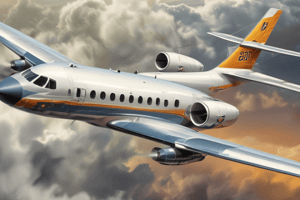Podcast
Questions and Answers
What is the primary reason why deploying flaps can lead to a reduction in airspeed?
What is the primary reason why deploying flaps can lead to a reduction in airspeed?
- Increased drag (correct)
- Decreased pitch
- Decreased power
- Increased lift
What should a pilot do to counteract the effect of a headwind on final approach?
What should a pilot do to counteract the effect of a headwind on final approach?
- Reduce power (correct)
- Decrease pitch
- Use more flaps
- Increase power
What is the primary role of the airspeed indicator in airspeed control?
What is the primary role of the airspeed indicator in airspeed control?
- To indicate the altitude of the aircraft
- To monitor the attitude of the aircraft
- To monitor the airspeed continuously (correct)
- To indicate the vertical speed of the aircraft
Why is situational awareness vital in airspeed control?
Why is situational awareness vital in airspeed control?
What is the result of not managing the deployment of flaps correctly?
What is the result of not managing the deployment of flaps correctly?
What is the primary reason why pilots must understand the effect of wind on airspeed?
What is the primary reason why pilots must understand the effect of wind on airspeed?
What is the benefit of cross-checking the airspeed indicator with other instruments?
What is the benefit of cross-checking the airspeed indicator with other instruments?
What is the primary objective of mastering airspeed control techniques?
What is the primary objective of mastering airspeed control techniques?
What should a pilot do in response to a change in airspeed due to environmental factors?
What should a pilot do in response to a change in airspeed due to environmental factors?
What is critical for airspeed control during the critical phases of takeoff and landing?
What is critical for airspeed control during the critical phases of takeoff and landing?
Deploying flaps decreases lift and drag.
Deploying flaps decreases lift and drag.
A tailwind on final approach requires less power to maintain airspeed.
A tailwind on final approach requires less power to maintain airspeed.
The airspeed indicator is the only instrument needed to ensure overall flight stability and control.
The airspeed indicator is the only instrument needed to ensure overall flight stability and control.
Situational awareness is only important during the critical phases of takeoff and landing.
Situational awareness is only important during the critical phases of takeoff and landing.
Configuration changes have no effect on airspeed.
Configuration changes have no effect on airspeed.
A headwind on final approach has no effect on airspeed.
A headwind on final approach has no effect on airspeed.
Instruments are not crucial for airspeed control.
Instruments are not crucial for airspeed control.
Mastering airspeed control techniques is only important for commercial pilots.
Mastering airspeed control techniques is only important for commercial pilots.
Pilots only need to be aware of wind conditions during takeoff and landing.
Pilots only need to be aware of wind conditions during takeoff and landing.
Airspeed control is only critical during takeoff and landing.
Airspeed control is only critical during takeoff and landing.
How do pilots need to adjust their pitch and power settings to counteract the effect of deploying flaps on airspeed?
How do pilots need to adjust their pitch and power settings to counteract the effect of deploying flaps on airspeed?
What are the two key factors that pilots need to consider when adjusting power settings to maintain airspeed during approach?
What are the two key factors that pilots need to consider when adjusting power settings to maintain airspeed during approach?
Why is it important for pilots to continuously monitor the airspeed indicator during flight?
Why is it important for pilots to continuously monitor the airspeed indicator during flight?
How do changes in wind direction affect airspeed control during approach?
How do changes in wind direction affect airspeed control during approach?
What is the primary benefit of cross-checking the airspeed indicator with other instruments during flight?
What is the primary benefit of cross-checking the airspeed indicator with other instruments during flight?
How does situational awareness contribute to effective airspeed control?
How does situational awareness contribute to effective airspeed control?
What is the primary consequence of not managing airspeed control during takeoff and landing?
What is the primary consequence of not managing airspeed control during takeoff and landing?
How do changes in aircraft configuration affect airspeed control?
How do changes in aircraft configuration affect airspeed control?
Why is it important for pilots to be proactive in responding to changes in airspeed?
Why is it important for pilots to be proactive in responding to changes in airspeed?
What is the primary role of instruments in airspeed control?
What is the primary role of instruments in airspeed control?
Flashcards are hidden until you start studying
Study Notes
The Role of Airspeed in Takeoff and Landing
- Airspeed control is critical for safety and efficiency in flight operations
- V-Speeds are essential speed thresholds for different phases of flight:
- V1: Decision speed, the point of no return where stopping is no longer an option
- VR: Rotation speed, where the aircraft lifts off the ground
- V2: Safe climb speed should an engine fail after V1
- VREF: Reference speed for landing, typically 1.3 times the stall speed in a specified landing configuration
Importance of Airspeed Control
- Flying too slowly can lead to a stall, while flying too fast can cause structural damage or overrun the runway
- Monitoring and adjusting airspeed requires a combination of throttle and flight control inputs
- Each aircraft has its own performance curve, and pilots must understand it to maintain control
Airspeed Management Techniques
- Establishing stable airspeeds early in the takeoff roll
- Maintaining a vigilant eye on instruments, particularly the airspeed indicator
- Building muscle memory for throttle and control adjustments
- Adjusting power settings to counteract changes in airspeed due to wind, configuration changes, or environmental factors
- Trimming the aircraft for the desired airspeed to reduce pilot workload and minimize the risk of stalling or overspeeding
- Using pitch control to adjust airspeed by changing the aircraft's attitude
Environmental Factors Affecting Airspeed Control
- Headwinds can reduce the required power to maintain airspeed, while tailwinds require more power
- Wind conditions should be monitored and factored into power settings to maintain a stable approach speed
- Situational awareness is critical to anticipate and respond to changes in airspeed due to environmental factors or aircraft configuration.
The Role of Airspeed in Takeoff and Landing
- Airspeed control is critical for safety and efficiency in flight operations
- V-Speeds are essential speed thresholds for different phases of flight:
- V1: Decision speed, the point of no return where stopping is no longer an option
- VR: Rotation speed, where the aircraft lifts off the ground
- V2: Safe climb speed should an engine fail after V1
- VREF: Reference speed for landing, typically 1.3 times the stall speed in a specified landing configuration
Importance of Airspeed Control
- Flying too slowly can lead to a stall, while flying too fast can cause structural damage or overrun the runway
- Monitoring and adjusting airspeed requires a combination of throttle and flight control inputs
- Each aircraft has its own performance curve, and pilots must understand it to maintain control
Airspeed Management Techniques
- Establishing stable airspeeds early in the takeoff roll
- Maintaining a vigilant eye on instruments, particularly the airspeed indicator
- Building muscle memory for throttle and control adjustments
- Adjusting power settings to counteract changes in airspeed due to wind, configuration changes, or environmental factors
- Trimming the aircraft for the desired airspeed to reduce pilot workload and minimize the risk of stalling or overspeeding
- Using pitch control to adjust airspeed by changing the aircraft's attitude
Environmental Factors Affecting Airspeed Control
- Headwinds can reduce the required power to maintain airspeed, while tailwinds require more power
- Wind conditions should be monitored and factored into power settings to maintain a stable approach speed
- Situational awareness is critical to anticipate and respond to changes in airspeed due to environmental factors or aircraft configuration.
Role of Airspeed in Takeoff and Landing
- Airspeed control is crucial for safety and efficiency in all flight operations
- Controlling airspeed during takeoff and landing is not just about adhering to speed limits, but about understanding the very lifeline of aircraft performance
V-Speeds
- V1: Decision speed, the point of no return where stopping is no longer an option
- VR: Rotation speed, where the pilot begins to pull back on the stick to lift the nose wheel off the runway
- V2: Takeoff safety speed, ensures sufficient climb performance should an engine fail
- VREF: Reference speed for landing, typically 1.3 times the stall speed in a specified landing configuration
Importance of V-Speeds
- V-Speeds are critical for safe aircraft operation, particularly during takeoff and landing
- Each speed has a specific significance and application in real-world flying scenarios
- V-Speeds are dependent on factors such as aircraft weight, center of gravity, altitude, runway length, and environmental factors
Airspeed Management
- Airspeed management involves throttle usage and flight control inputs
- Environmental influences, such as wind, require pilots to adapt their techniques
- Pilots must be able to adjust airspeed without changing engine thrust too aggressively
Practical Tips
- Establish stable airspeeds early
- Maintain a vigilant eye on instruments
- Build muscle memory for throttle and control adjustments
- Feel and finesse are essential when responding to environmental influences
Performance Speeds for Safe Operations
- V1: Commit-to-flight speed
- VR: Lift-off point
- V2: Climb safeguard
- VREF: Threshold guardian
- Understanding and respecting these speeds is a non-negotiable safety standard
Configuration Changes and Wind Effects
- Deploying flaps increases lift and drag, which can cause a reduction in airspeed if not managed correctly
- Pilots must understand how to counteract these changes with adjustments in pitch and power
- Wind effects, such as headwinds and tailwinds, require pilots to adjust power settings to maintain a stable approach speed
Instruments and Situational Awareness
- Airspeed indicator should be monitored continuously
- Cross-checking with other instruments, such as the attitude indicator, altimeter, and vertical speed indicator, ensures overall flight stability and control
- Situational awareness is vital, and pilots should always be prepared for changes in airspeed due to environmental factors or aircraft configuration
Studying That Suits You
Use AI to generate personalized quizzes and flashcards to suit your learning preferences.




